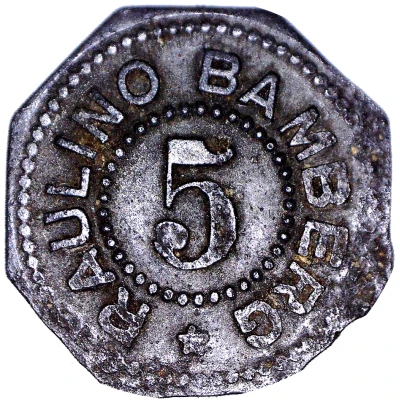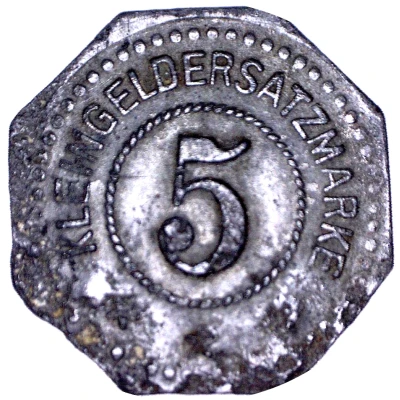


© T. R. Aikins
5 Pfennigs - Bamberg (Raulino) ND
| Zinc | 1.60 g | 19.5 mm |
| Issuer | City of Bamberg (notgeld) (Federal state of Bavaria) |
|---|---|
| Type | Standard circulation coin |
| Value | 5 Pfennigs (5 Pfennige) (0.05) |
| Currency | Mark (1914-1924) |
| Composition | Zinc |
| Weight | 1.60 g |
| Diameter | 19.5 mm |
| Thickness | 1.0 mm |
| Shape | Octagonal (8-sided) |
| Technique | Milled |
| Orientation | Medal alignment ↑↑ |
| Demonetized | Yes |
| Updated | 2024-10-04 |
| Numista | N#143151 |
|---|---|
| Rarity index | 97% |
Reverse
Beaded circle surrounding legend with three stars
legend surrounding threaded circle
Threaded circle surrounding denomination in center
Script: Latin
Lettering:
KLEINGELDERSATZMARKE
5
***
Edge
Plain
Comment
Menzel: BBBIssuing authority: [Privat, Bayern]
Johann Peter Raulino gründete 1820 eine Tabakfabrik, die um 1850 erweitert wurde. 1913 wurde der damalige Firmeninhaber in den Adelsstand erhoben (Dr. Richard Freiherr von Michel-Raulino). Die Tochter Lilly Stromeyer von Michel-Raulino war nach dem 2. Weltkrieg mit dem Flugzeugkontrukteur Willy Messerschmitt verheiratet.
In den Zeiten des 1. und 2. Weltkrieges war Raulino einer der bedeutendsten deutschen Rauchtabakfabriken, wobei zeitweise Zweigniederlassungen in Osteuropa (Lodz, Minsk und Kiew) bestanden. Nach dem 2. Weltkrieg wurden die unternehmerischen Aktivitäten auf andere Geschäftsbereiche verlagert und 1957 die Produktion von Tabakwaren eingestellt.
Heute erinnert das Raulinohaus am Grünen Markt 14 an die Firma und Familie.
Lose English translation:
Johann Peter Raulino founded in 1820 a tobacco factory, which was expanded in 1850. In 1913, the then company owner was raised to the peerage (Dr. Richard Baron von Michel-Raulino). The daughter Lilly Stromeyer of Michel-Raulino was married to the aircraft designer Willy Messerschmitt after the Second World War.
In the times of the 1st and 2nd World War Raulino was one of the most important German smoking tobacco factories, with at times branch offices in Eastern Europe (Lodz, Minsk and Kiev) existed. After the Second World War, the entrepreneurial activities were transferred to other business areas and in 1957 the production of tobacco products ceased.
Today the Raulinohaus on the green market 14 reminds of the company and family.
Interesting fact
The 5 Pfennigs - Bamberg (Raulino) ND coin was issued during a time of economic turmoil in Germany, known as the "Inflationary Period" (1914-1924), when the value of the German mark plummeted, and the price of goods and services skyrocketed. To combat this issue, many cities and towns, including Bamberg, issued their own emergency currency, known as "notgeld," which was backed by the city's credit and was used as a substitute for the devalued German mark. The 5 Pfennigs - Bamberg (Raulino) ND coin is a rare example of this emergency currency, and its design features the city's coat of arms and a unique serial number.